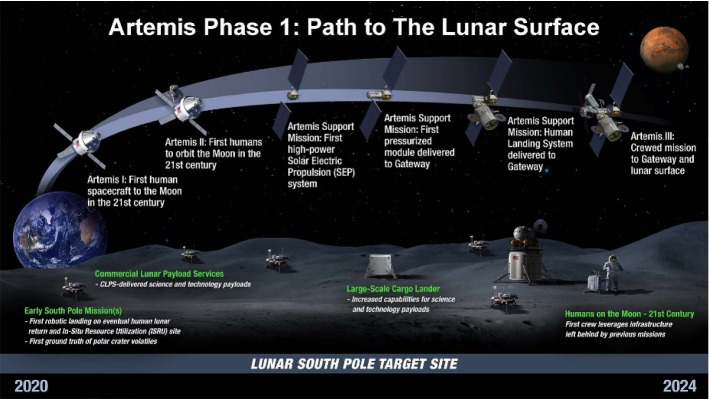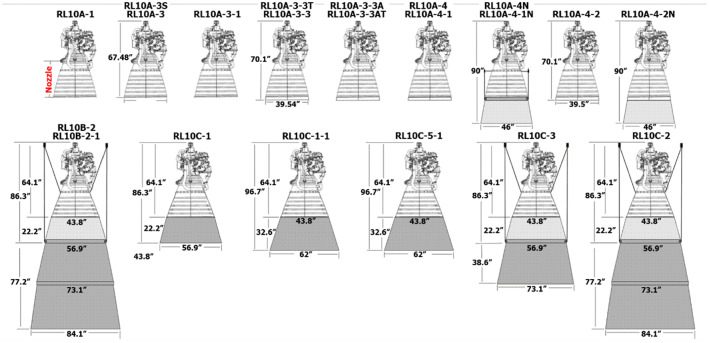Abstract
SpaceX's successful development of reusable rockets and the realization of low-cost operations have significantly impacted the space industry, institutions, and companies. Price competitiveness has become a hot topic for launch vehicle development. A hydrogen-fueled rocket engine can be its solution. The developed countries are attempting to improve the performance and reliability of engines using a hydrogen-fuel. This paper summarizes the development and operation trends of hydrogen-fueled rocket engines of developed countries. It provides fundamental data for hydrogen-fueled rocket engine development, which is expected to be helpful in its future development.
Keywords: Hydrogen-fueled rocket engine, Launch vehicle, Trend
Introduction
Past launch vehicles did not face cost problems, because state-led development was the mainstream. However, price competitiveness has recently become important due to emerging commercial companies, such as SpaceX. In this age of space development competition, countries that have developed or are developing a launch vehicle with relatively poor performance need to develop a high-performance launch vehicle engine. The development of a next-generation launch vehicle is required considering the competition. Fuel choice is one of the critical factors determining the performance of next-generation launch vehicles. Careful selection of the propellant is required, because it is directly related to the overall performance and the technology needed for its development. Particularly, kerosene, methane, and hydrogen can be considered proper candidates for next-generation fuels for improving the launch vehicle performance.
Methane can be the right candidate for next-generation fuel because of its cheaper cost, higher specific impulse and coking limits, and lesser carbon soot compared to kerosene [1]. In addition, it has attracted attention as fuel for Mars explorers, because it can be produced there. However, it is not easy to expect improvement in transportation capacity using only propellants, because it has a less specific impulse than hydrogen. In addition, it is difficult to estimate the development cost and technical difficulty because of the lack of a commercialized system. The development of liquid methane-fueled engines appeared difficult that even Raptor engines developed by SpaceX, a leader in methane engines, delayed development schedules [2]. Hydrogen is an eco-friendly fuel due to the absence of CO2 emission and does not cause carbon soot from its combustion, so maintenance costs are reduced. In addition, hydrogen improves the payload capability due to almost 30% higher specific impulse than those offered by conventional hydrocarbon propellant [3, 4]. However, there have been some technical difficulties in developing a hydrogen-fueled engine, and it has been analyzed in Part II. In this regard, there are some disadvantages: the volume of the propellant tank increases due to the low energy density per unit volume, high insulation technology is required due to the low boiling point, and the maintenance cost may increase due to hydrogen brittleness and air leakage [5]. Despite these technical difficulties, the development and application of hydrogen engines continues, because the high specific impulse of hydrogen has a significant advantage. In particular, as the demand for performing various missions in space at once has increased recently, heavy-lift launch vehicles with the launch capability of multiple satellites are consistently preferred [6]. This is why most large commercial launch vehicles employ a hydrogen engine on the upper stage. A hydrogen-fueled engine secures competitive prices by reducing the launch cost ($/kg) and may be one of the most appropriate solutions for next-generation launch vehicles.
However, research on hydrogen-fueled rocket engines remains conceptual in most countries, except in some developed countries, due to the lack of technology for producing and utilizing liquid hydrogen. Recently, a hydrogen-fueled rocket engine has been considered an engine applicable to high-performance launch vehicles in several countries, because infrastructure is actively being built worldwide according to the hydrogen economy roadmap or the availability of hydrogen fuel. Several hydrogen fuel-related studies briefly covered the development trends of hydrogen-fueled rocket engines [7, 8]; however, the content was severely short, and the characteristics of the developed engine were not specifically addressed. Hence, this paper aims to provide primary information by analyzing the development trend of hydrogen-fueled rocket engines in developed countries.
Performance and Operation Trend of Hydrogen-Fueled Rocket Engine
United States
The development of expendable launch vehicle (ELV) began under the leadership of the National Aeronautics and Space Administration(NASA) and the United States Department of Defense (DoD) to compete with the Soviet Union in space during the cold war. Various hydrogen engines were developed: RL10 in 1963 and J-2 in 1967, which was used in the lunar probe Saturn V. In 1972, NASA developed the space shuttle following its reusable launch vehicle development plan. They phased out the existing ELV due to using a single launch vehicle. However, the efficiency of the space shuttle, which was initially aimed at reducing costs, raised questions, because its cost was approximately 1.4–3.3 times higher than that of the ELV.
Repeatedly, the failures of the Challenger in 1986 and the Columbia in 2003 were the cause of the shuttle's diversification strategy. It led to the emergence of commercial companies, such as SpaceX and Blue Origin; the New Space era was led by private companies. Currently, the United States is conducting the Artemis program, the second manned space exploration project led by NASA, and Korea will also participate as the 10th country from May 2022. Artemis program plans to send people to the moon by 2025. Figure 1 shows the mission goals by 2024.
Fig. 1.
NASA's plan to use the moon and the vehicles of the Artemis program [9]
NASA is currently developing the space launch system (SLS), the next launch vehicle for the space shuttle, to achieve this goal. Figure 2 shows the development process of the SLS. It shows that only a single super heavy lift launch vehicle (SHLLV) is being developed under the SLS program; however, it has been gradually upgraded. The recently designed Block 2 will replace the second stage of the SLS with a new exploration upper stage (EUS) using the J-2X engine instead of the RL10.
Fig. 2.

Block evolution of SLS vehicle [10]
Table 1 shows the specifications of major hydrogen-fueled rocket engines of the United States. Except for the BE Series engine, whose specifications are not disclosed, it shows that the performance for the RS-25 engine is higher than the RS-68 engine. The RS-25 demonstrates a high performance based on high combustion pressure by adopting a staged combustion cycle during the space competition with the Soviet Union during the cold war. However, the RS-68 is estimated to have relatively low performance, because it adopts a gas generator cycle that generates a loss of specific impulse to reduce cost.
Table 1.
Characteristics of hydrogen-fueled rocket engine of the United State
| Engine | RS-25 | RS-68 | BE-3 | BE-7 |
|---|---|---|---|---|
| Cycle | Staged combustion | Gas generator | Combustion tap-off | Dual expander |
| Status | Retired | Active | Active | Under development |
| Development period | 1970–1977 | 1997–2001 | 2010–2015 | 2011– |
| First flight | 1981 | 2012 | 2021 | 2022 (plan) |
| Thrust [tonf] | 232.4 | 337.9 | 49.9 | 4.1 |
| Chamber pressure [bar] | 206.4 | 102.6 | – | – |
| Specific impulse [s] | 452.3 | 410 | – | – |
| Thrust-to-weight ratio | 73.1 | 45.3 | – | – |
| Application | SSME main stage | Delta IV main stage | New shepard | Blue moon Lunar lander |
SSME (RS-25)
NASA developed the space shuttle main engine (SSME) in 1970, conducted its first engine test in 1977, and used as for the first stage of the space shuttle in 1981—the first reusable launch vehicle. The engine adopted a staged combustion cycle for high performance and produced a specific impulse of 452 s and 232.5 tonf (ton-force) in a vacuum. High-strength materials were required due to high performance; moreover, more than 1,500 parts were manufactured with Inconel 718 to prevent hydrogen embrittlement [11]. However, the possibility of failure was high despite these efforts due to the complex structure and high combustion pressure, largely increasing the maintenance procedures and costs. Hence, the launch cost at that time was more than 14 times higher than the current Falcon 9. Eventually, the disasters of Challenger in 1986 and Columbia in 2003 occurred, economic feasibility came to the surface, and the SSME was retired in 2011. Recently, the SSME plans to reuse it as the first stage engine for the SLS through the Artemis program. Several improvements are currently underway to use liquid hydrogen-fueled rocket engines. It aims to reduce the development cost by approximately 30% compared to the existing RS-25 by eliminating the reuse function for price adequacy and shortening the development and manufacturing process through additive manufacturing (see Fig. 3). In addition, thermal barrier coating (TBC) and ceramic matrix composites (CMCs) will be applied to combustion chambers to lower thermal conductivity, which will increase combustion efficiency and ease cooling requirements.
Fig. 3.
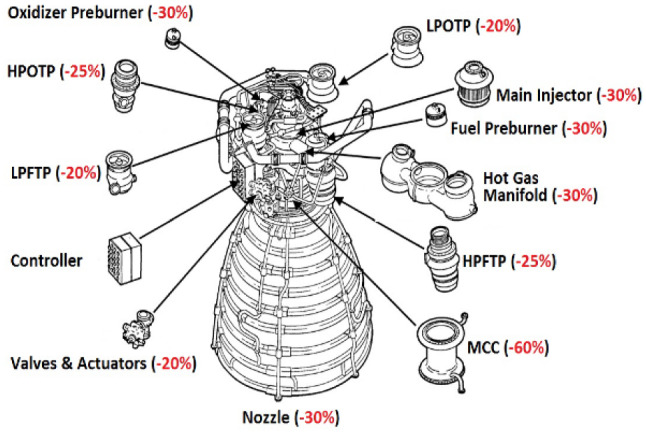
RS-25 cost reduction objectives [10]
RS-68
The RS-68 engine was developed by Rocketdyne in 2001 as a low-cost engine of SSME; it has been used as the first stage engine of the Delta IV, starting with the first launch in 2012. The engine was adopted a gas generator cycle for high efficiency and reliability; it produced a specific impulse of 410 s and 338 tonf in a vacuum. The engine reduced the number of parts by 80% compared to RS-25 and improved malleability and ductility by introducing hot isostatic pressure (HIP) to the combustion chamber, shortening the life cycle from 24 to 12 months. In addition, since the regenerative cooling has a complicated manufacturing process, the cooling method of the nozzle changes from regenerative cooling to ablation cooling. The combustion pressure was increased by approximately 5 bar to improve the transport capacity of the Delta IV; the injector was redesigned to enhance the mixing and combustion efficiency. After that, it was upgraded to the RS-68A engine by significantly increasing the efficiency and reducing the turbine load through redesigning the turbopump [12]. Figure 4 shows the structure of the RS-68 engine. The nozzle for direction and roll control was mounted on the turbine exhaust port.
Fig. 4.
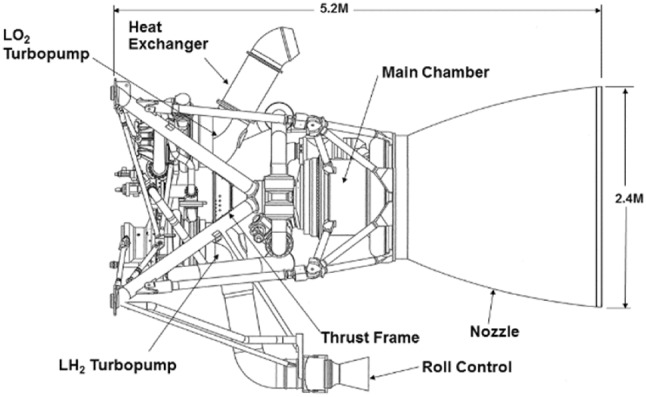
Schematic drawings of RS-68 engine [13]
BE-3 and BE-7
The BE-3 engine was developed in 2015 by Blue Origin. It was used in New Shepard—the commercial human-crewed spacecraft, which successfully launched in October 2021, carrying four passengers. Figure 5 shows the structure of the engine. The engine adopts a combustion tap-off cycle in which most of the fuel expanded through heat transfer from the nozzle is exhausted to the combustion chamber after driving the turbine. The vacuum thrust is approximately 72.3 tonf; the reusable engine was developed to 5:1 throttling for safe landing during vertical take-off and landing. In addition, the BE-3U with an open expander cycle and nozzle extension is being developed for operation in the second stage of New Glenn, a large launch vehicle targeting LEO with a payload of 45 tons. Furthermore, the BE-7 engine is currently under development; it is a dual-expander cycle engine that can control the thrust of up to 0.9 tonf for precise landing on the lunar surface [15]. Figure 6 shows the structure of the BE-7 engine; the nozzle expansion ratio of the BE-7 is larger than that of the BE-3, because it is an upper-stage engine.
Fig. 5.
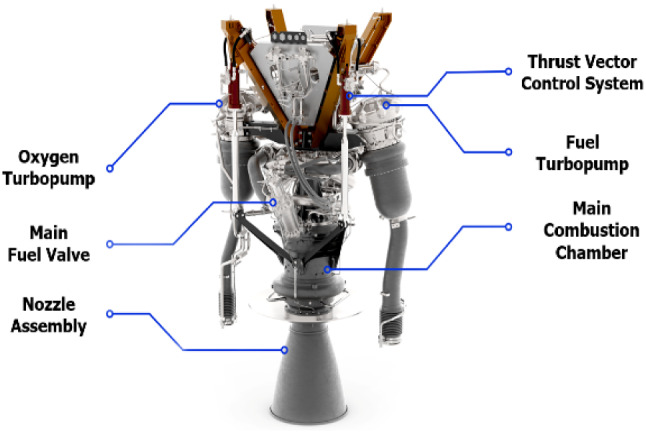
Schematic drawings of BE-3 engine [14]
Fig. 6.

Schematic drawings of BE-7 engine [16]
RL10
The RL10 engine was developed by Pratt & Whitney in the 1950s and launched in 1962 as the world's first hydrogen-fueled rocket engine. It was designed to control the thrust of lunar landers. The engine applied an expander cycle that uses expansion energy generated as the fuel passes through the cooling channel of the combustion chamber wall to drive the turbine. The performance of the RL10 engine has been continuously improved since the prototype A-1. Figure 7 shows its evolution. Table 2 shows that the specific impulse and thrust-to-weight ratio of the RL10 engine were improved through performance improvements.
Fig. 7.
Evolution of the RL10 engine series [17]
Table 2.
Characteristics of RL10 hydrogen-fueled rocket engine
| Engine | RL10A-1 | RL10A-3-3A | RL10A-4 | RL10B-2 | RL10C-1 |
|---|---|---|---|---|---|
| Cycle | Expander | ||||
| Status | Retired | Retired | Retired | Active | Active |
| Development period | 1958–1961 | –1981 | 1988–1991 | 1995–1998 | 2010–2013 |
| First flight | 1962 | 1981 | 1992 | 1998 | 2014 |
| Thrust [tf] | 6.8 | 7.5 | 9.5 | 11.2 | 10.4 |
| Chamber pressure [bar] | 20.7 | 32.1 | 39.8 | 44.4 | 44.0 |
| Specific impulse [s] | 422 | 446.4 | 449 | 466.5 | 449.7 |
| Thrust-to-weight ratio | 51.9 | 54.2 | 56.1 | 40.5 | 57.0 |
| Application | Centaur A | Centaur B/C/D/E | Centaur IIA | Delta III, IV upper stage | Centaur V upper stage |
The RL10A-1 was the first operational liquid hydrogen-fueled rocket engine. It was an expander cycle engine with geared turbopump, regeneratively cooled chamber and nozzle, and a cooled porous injector face. The engine required boost pumps to avoid cavitation. Furthermore, chamber pressure was controlled using a thrust control valve to bypass flow past the turbine. The RL10A-3 model incorporated fast-opening chill down valves to better control the shutdown transient and improved oxidizer pump suction capability. This model was used on the Centaur and in a six-engine cluster on the Saturn S-IV. Externally, the engine was virtually indistinguishable from the RL10A-1. In addition, the main functional difference from the A-1 model was an increment of 5 s (to 427) in specific impulse.
Combustion efficiency and air leakage issues of the RL10A-3-1 engine have been improved by changing the shape of the injectors. The engine used a fast-cooling valve to control transients and improve oxidant pump intake performance. The RL10A-3-3 engine reduced the propellant required to cool the gearbox between the turbine and the pump and improved the specific thrust by increasing the combustion pressure. In addition, the overall engine size was reduced by decreasing the nozzle throat, and the efficiency was improved by redesigning the pump and turbine.
The major upgrade to the RL10 family was embodied in the RL10A-4 engine. First, The RL10A-4 has 25% more thrust than the RL10A-3-3A engine for the Atlas-Centaur IIA and IIAS second stage. Therefore, the modified turbopump assembly with a new oxygen pump and an extendible radiation-cooled silicide-coated columbium nozzle extension from 61:1 to 84:1 expansion ratio was applied. Second, the reliability was improved by approximately 28% through an electronic ignition device. Third, the combustion chamber and primary nozzle geometry changes that had been affected in the RL10A-3-3A with a silver insert at the throat were incorporated into the basic shape of the tubular chamber. The liquid oxygen pump was completely redesigned, and other revisions to the turbomachinery provided the required increase in propellant flow and chamber pressure.
The RL10B-2 engine was derived from the RL10A-4-1; it was developed for the upper stage of the Delta III and Delta IV in a single-engine configuration. The engine operates at a 4% higher chamber pressure and a higher fixed 6.0 mixture ratio than those of the RL10A-4-1. The most distinctive feature of the RL10B-2 model is its large translating nozzle extension. The specific impulse was increased using an extendible carbon–carbon nozzle. The expansion ratio of the RL10B-2’s nozzle is 285:1, and that of RL10A is 84:1. The turbomachinery was unchanged, and the chamber was recontoured to accommodate the new nozzle extension.
The RL10C-1 made its first flight in December 2014. The RL10C blends the configurations of the RL10A-4 engine from Atlas and the RL10B-2 engine to power the Delta IV. The turbomachinery configuration on the RL10C is familiar with the RL10A; however, the RL10C adopts the chamber and injector configuration from the RL10B. The noticeable change on the RL10C is a shortened version of the carbon–carbon nozzle extension used by Delta. Other mods include avionics for active propellant mixture ratio control—a current capability on the RL10A—and a redundant dual direct spark ignition system standard on the Atlas.
Japan
Japan has been conducting technology transfer and development partnerships for the Delta engine of the United States since 1975 at the National Space Development Agency of Japan (NASDA) to obtain liquid rockets after the solid rocket Mu from 1966. The two-stage launch vehicle N-1 was developed through this, gaining the foundation for the space industry. The U.S. Delta engine was used as a booster until the N-1 in 1981 and the H-I launch vehicle in 1992. However, Japan decided to develop rockets indigenously and decided to develop hydrogen-fueled rocket engines while aiming for the best performance after the U.S. ended technical support. A gas generator cycle engine LE-5 was developed and applied to the upper stage of the H-I launch vehicle. However, several explosions occurred due to hydrogen confidentiality issues. The LE-5A, which was changed to the expander cycle, was applied to the H-II launch vehicle—the next launch vehicle. Meanwhile, the LE-7 engine, developed for the first stage of the H-II, required improvement due to cavitation in the fuel pump impeller. Therefore, the inducer was redesigned and replaced with the LE-7A with improved reliability. It was applied to the H-IIA launch vehicle and successfully launched in 2001; it is still in operation today.
The H-III launch vehicle capable of carrying a payload of up to 4000 kg into a sun synchronous orbit (SSO) has been in development since 2013 and is set to be launched in the first quarter of 2022. Table 3 lists the specifications of Japan's major hydrogen-fueled rocket engines. The specific impulse of the LE-5 series is about 450 s, and the thrust-to-weight ratio is about 50.The LE-5 series showed higher specific impulse and lower thrust-to-weight ratio than the first stage engine, LE-7A and LE-9. Although the LE-7A is the first-stage engine, it has a similar specific impulse to the LE-5 series, because it has no loss due to exhaustion of the fuel through the staged-combustion cycle. It shows that the thrust-to-weight ratio is more significant in the first-stage engine with greater thrust than the upper engine.
Table 3.
Characteristics of hydrogen-fueled rocket engines of Japan
| Engine | LE-5 | LE-5A | LE-5B | LE-7A | LE-9 |
|---|---|---|---|---|---|
| Cycle | Gas generator | Expander (nozzle bleed) | Expander (chamber bleed) | Staged combustion | Expander bleed |
| Status | Retired | Retired | Active | Active | Under development |
|
Development period |
1977–1985 | 1986–1991 | 1994–1999 | 1994–2000 | 2006– |
| First flight | 1986 | 1994 | 2001 | 2001 | 2022 (plan) |
| Thrust [tf] | 10.0 | 13.7 | 15.4 | 121.4 | 165.3 |
| Chamber pressure [bar] | 36.5 | 39.8 | 35.8 | 120.0 | 100.0 |
| Specific impulse [s] | 442 | 453 | 450 | 441 | 425 |
| Thrust-to-weight ratio | 35.6 | 50.2 | 51.9 | 65.9 | 62.5 |
| Application | H-I 2nd stage | H-II 2nd stage | H-IIA/B 2nd stage | H-IIA 1st stage | H-III 1st stage |
Figure 8 shows the structure of the LE engine series. LE-5, 5A, and 5B had a large nozzle expansion ratio because of the upper stage engine. The nozzle extension of the LE-5A consisted of brazed long tapered tubes due to cooling the nozzle. However, the nozzle extension design of the LE-5B was returned to the dump cooled as the LE-5.
Fig. 8.
LE-5 series
The LE-5 engine was the first hydrogen-fueled rocket engine of Japan developed by Mitsubishi Heavy Industries started in 1977 and completed in 1985. It was first used as an upper stage engine for the H-I launch vehicle in 1986 and was retired in 1992. The engine was adopted a gas generator cycle and produced a specific impulse of 449 s and 10.5 tonf in a vacuum. The nozzle was cooled through the dump cooling method; the start-up method using vaporized hydrogen in the combustion chamber cooling tube was applied [18].
The LE-5A engine was developed between 1986 and 1991 to be used on the upper stage of the H-II launch vehicle; it was first launched in 1994. However, the LE-5A was retired after two consecutive failures in 1998; the H-IIA launch vehicle was then developed the following year. the LE-5A required 18% more thrust compared to the LE-5. Therefore, the diameter of its nozzle throat and injector orifice was enlarged. The engine was modified a gas generator cycle into an expander bleed cycle for high efficiency and reliability, producing a specific impulse of 452 s and 12.4 tonf in a vacuum. In addition, a swing valve was added to reduce the rotation speed of the turbopump without changing the cooling characteristics of the combustion chamber and the nozzle.
Development of the LE-5B engine started in 1994 to improve thrust, restart more than twice, reduce costs, and improve reliability. Its development was completed in 1999. It was mounted on the upper stage of the H-IIA—the successor model of the H-II launch vehicle. It has remained in operation since its first launch in 2001 (Fig. 9).
Fig. 9.
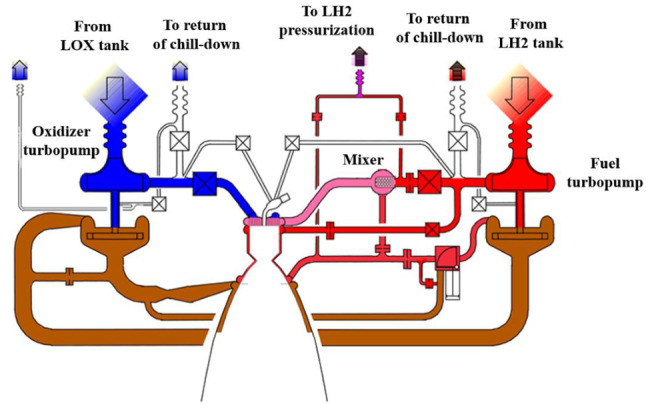
Schematic diagram of LE-5B-3 engine [21]
The LE-5B applied regenerative cooling to the nozzle and changed to a copper material to increase the heat exchange in the nozzle, unlike the LE-5A, which exhausts the fuel that drives the turbine through the combustion chamber and nozzle [19]. In addition, the engine lowered the temperature of the fuel passing the turbine and increased the pump's speed to reduce the length of the cooling channel in the combustion chamber. The injector structure was simplified, its parts were reduced from 208 to 127 to reduce production costs, and a spark igniter was used to enable multiple restarts [20]. The LE-5B-2 engine was developed to suppress low-frequency instability in 2003. The mixer of the engine was modified, which is installed upstream of the injector. It mixes the liquid hydrogen from the turbopump and the gaseous hydrogen from the regenerative cooling channels. The phase change and miniaturization of the injection port promoted the atomization of liquid oxygen, reducing the oscillation of combustion pressure by 50%. Since 2014, the LE-5B-3 engine has been developing to increase the specific impulse and combustion time. The mixer design of the LE-5B-3 was modified to reduce the difference between the maximum and minimum injection temperatures, as shown in Fig. 10. The LE-5B-3 engine scheduled to be applied to the upper stage of the H-III launch vehicle, will be launched in the first quarter of 2022.
Fig. 10.
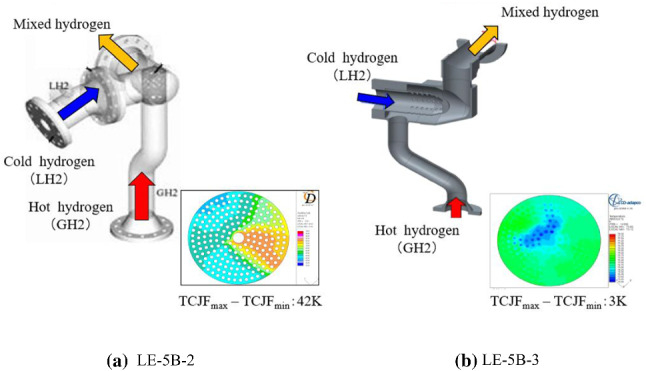
Mixer designs and the CFD result [21]
LE-7 series
The MB-3–3 engine was used as a single-stage for the H-I launch vehicle, and the engine was license-produced by the US Delta rocket [22]. However, the development of a hydrogen-fueled engine began owing to the inferior performance of kerosene. The LE-7 was a staged combustion cycle engine used in the first stage of H-II, which began development in 1986 and was completed in 1994. The engine produced a specific impulse of 446 s and 110 tonf in a vacuum. However, it was retired due to an explosion due to an overreaction by the time difference between the mixing of propellants in the combustor and destruction of the inducer at the top of the fuel pump to cavitation [23].
The LE-7A engine is an improved version of the LE-7 to be used in the first stage of the H-IIA. The engine produced a specific impulse of 441 s and 121.4 tonf in a vacuum. It was developed to solve the problems mentioned above, reduce costs, and increase reliability. The configuration of the inducer was changed to solve the cavitation problem and increase reliability. The welding procedure was simplified, and the number of parts constituting the injector was reduced. In addition, the inducer was redesigned to increase the lift of the fuel pump, and the material processing of the turbine nozzle was changed from forging to precision casting [23]. Furthermore, the rotation speed and turbine inlet temperature were reduced by enlarging the nozzle throat area of the combustion chamber, and the nozzle cooling method was changed from a dump cooling method to a film cooling method.
LE-9
The LE-9 engine is scheduled to be used in the first stage of the H-III; its development began in 2015 with an aim to launch it in the first quarter of 2022. The engine produced a specific impulse of 425 s and 150 tonf in a vacuum. The engine adopted an expander bleed cycle to enhance reliability and lower manufacturing cost. Moreover, unnecessary pneumatic piping was removed by operating the main valve electromechanically; oxygen-free copper with high hydrogen embrittlement and high thermal conductivity was applied to compensate for the low heat flux of the combustion chamber [23]. The injector, which had assembled more than 500 parts through machining, was manufactured in one piece using the selective laser melting (SLM) technique, reducing manufacturing time and cost [24]. Figure 11 shows the injector of the LE-9 engine to which the SLM technology was applied; liquid oxygen flows in the center of approximately 500 double pipes, and liquid hydrogen flows outside.
Fig. 11.
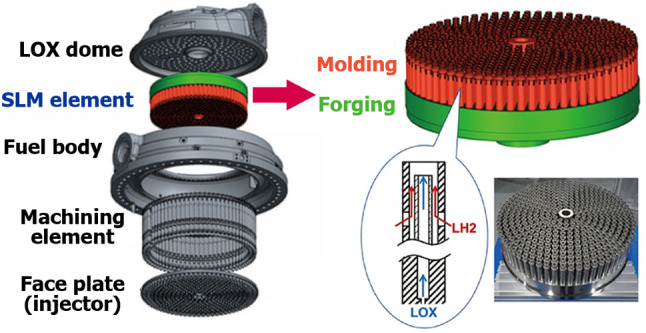
SLM technology application in LE-9 engine injector [24]
China
Figure 12 shows the operational status of the Chinese launch vehicle, Long March (LM). The R&D of rockets began in 1956 with the technical support of the former Soviet Union. Furthermore, the first self-developed space launch vehicle, LM-1, was launched in 1970. Hydrazine-based fuels were used from LM-1 to LM-4; however, the upper stage of LM-5 was changed to hydrogen-fueled engines, such as those of the YF series due to pollution and environmental problems. Figure 13 shows the number and success rate of launches by year in China. The number of launches has rapidly increased since the 2000s, offering a very high success rate of 96.7%. The tendency shows that the technology of China's space launch vehicle has entered a very sustainability stage both quantitatively and qualitatively.
Fig. 12.
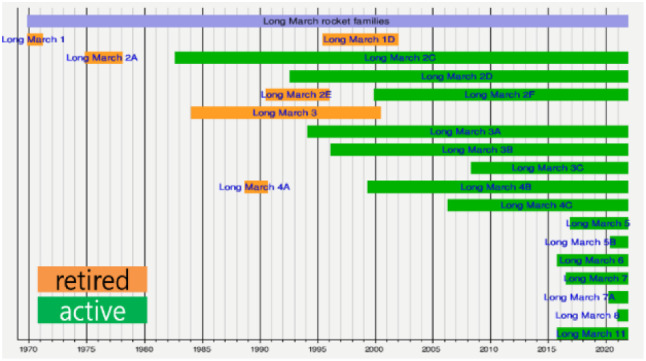
Development status of hydrogen-fueled rocket engine of China [25]
Fig. 13.

Number of launches and success rate of Chinese launch vehicle [26]
Table 4 shows the specifications of China's major hydrogen-fueled rocket engines. In the early 1970s, the specific impulse at the level of 420 s was improved to 450 s, and the thrust-to-weight ratio also increased from 19 to 40 or more. Currently, the LM-9 launch vehicle, capable of carrying 140 tons of payload into low earth orbit (LEO), is being developed for human-crewed lunar exploration and Mars missions. It will be equipped with the YF-90 hydrogen-fueled engine [27] (Fig. 14).
Table 4.
Characteristics of hydrogen-fueled rocket engine of China
| Engine | YF-73 | YF-75 | YF-75D | YF-77 | YF-90 |
|---|---|---|---|---|---|
| Cycle | Gas generator | Gas generator | Expander | Gas generator | Staged combustion |
| Status | Retired | Active | Active | Active | Under development |
| Development period | 1975–1983 | 1982–1994 | 2006–2012 | 2002–2013 | 2016– |
| First flight | 1984 | 1994 | 2016 | 2016 | 2030 (plan) |
| Thrust [tf] | 5.0 | 8.8 | 9.9 | 78.7 | 120 |
| Chamber pressure [bar] | 26.8 | 36.7 | 41 | 102 | – |
| Specific impulse [s] | 420 | 440 | 442 | 430.1 | 453 |
| Thrust-to-weight ratio | 19.1 | 32.7 | 41.1 | – | – |
| Application | LM-3 3rd stage | LM-3A, B, C 3rd stage | LM-5 2nd, 3rd stage | LM-5 1st stage | LM-9 2nd stage |
Fig. 14.
YF-73
The YF-73 is China's first liquid hydrogen-fueled engine, designed by the Beijing Aerospace Propulsion Institute (BAPI) in 1975 and developed by the China Academy of Launch Vehicle Technology (CALT) in 1984. The engine was used as the 3rd stage engine of the LM-3 from 1984 to 2000 and produced a specific impulse of 420 s and 4.5 tonf in a vacuum. China established infrastructures, such as production, storage, and transportation of liquid hydrogen by developing the YF-73; it required core technologies, such as cryogenic wheels and high-speed bearings for operating turbopumps with high gear ratios [28]. However, it recorded three failures out of 13 flights and was retired in 2000 due to low reliability and transport capacity.
YF-75
In 1982, China began to develop engines with higher thrust than the YF-73 as the satellites increased in weight and size. Development of the YF-75 engine was completed in 1994, and it is still used as the third-stage engine of LM-3A, B, and C. The engine adopted a gas generator cycle and produced a specific impulse of 440 s and 8.0 tonf in a vacuum. The payload in the LEO orbit of LM-3A equipped with YF-75 was 8.5 tons, which is higher than that of LM-3 (5 tons). The stability of the rotor was increased by applying for the double elastic support; the spiral tube was welded to the extended nozzle to reduce the mass, and propellant consumption was optimized by controlling the mixture ratio [30].
The YF-75D was developed to improve reliability and reduce development costs in 2006–2012. The engine adopted an expander cycle and produced a specific impulse of 442 s and 9.0 tonf in a vacuum. The length of the combustion chamber was increased more than twice compared to the YF-75 to increase heat transfer, and a reignition function was added to make it suitable for various tasks. Moreover, a metal rubber damper was installed to reduce noise and vibration of the hydrogen turbopump, and the elastic support was cased with a hybrid ceramic ball bearing [28].
YF-77
The development of the YF-77 engine, the first booster engine of China, was started in 2002 and completed in 2013. It is still used as the first stage of the LM-5. The engine adopted a gas generator cycle due to the requirements of low cost, high reliability, and proper performance of a consumable engine. It produced a specific impulse of 430 s and 71.4 tonf in a vacuum. Instead of developing a large engine, the clustering of two medium-sized engines was used to reduce costs and shorten development time. A regenerative cooling method was applied to the combustion chamber, and a dump cooling method was applied to the nozzle.
YF-90
The YF-90 engine is scheduled to be applied to LM-9, super heavy lift launch vehicle (SHLLV), such as Russia's Yenisei, NASA's SLS, SpaceX's Starship, and Falcon Heavy. The engine will adopt a staged combustion cycle with four units in the 2nd stage and one unit in the 3rd stage [29].
Europe
Research on liquid rockets began in 1952 before establishing the European Space Agency (ESA). Thereafter, Europe developed the Ariane launch vehicle. The Vulcain engine, the first stage of the Ariane 5, was developed in 1996 and is still in operation. It is considered the most reliable launch vehicle. The Ariane 6 launch vehicle is currently being developed to halve the cost compared to Ariane 5, and increase the capacity for the number of launches per year. The first stage will be to mount the Vulcain 2.1, a hydrogen-fueled engine of 130 tonf thrusts with gas generator cycle, and the second stage will be to mount the Vinci, a hydrogen-fueled expander cycle engine with 2 tonf thrusts. The Ariane 6 was scheduled to be launched in May 2020. However, the launch was delayed twice due to the COVID-19; its launch is expected at the end of 2022 [31].
Table 5 lists the specifications of major hydrogen-fueled rocket engines of Europe. It shows that the specific impulse of the Vinci is about 440 s, which is relatively higher than that of other engines. Because the Vinci is adopted a closed expander cycle that the turbine exhaust gas enters the combustion chamber again. The thrust weight ratio is 40 for the HM7 and 60–80 for the rest of the engines (Fig. 15).
Table 5.
Characteristics of hydrogen-fueled rocket engine of Europe
| Engine | HM7A | HM7B | Vinci | Vulcain | Vulcain 2.1 |
|---|---|---|---|---|---|
| Cycle | Gas generator |
Gas generator |
Expander | Gas generator | Gas generator |
| Status | Retired | Active | Under development | Retired | Under development |
| Development period | 1973–1979 | 1983–1986 | 2003– | 1988–1996 | 2014– |
| First flight | 1979 | 1986 | 2022 (plan) | 1997 | 2022 (plan) |
| Thrust [tf] | 6.9 | 7.3 | 20.2 | 116.2 | 137.7 |
| Chamber pressure [bar] | 30 | 35 | 61 | 100 | 116– |
| Specific impulse [s] | 443 | 447 | 457 | 431 | 434 |
| Thrust-to-weight ratio | 42.2 | 40.1 | 65.6 | 81.1 | 69.4 |
| Application | Ariane 1 3rd stage | Ariane 2, 3, 4 3rd stage | Ariane 6 2st stage | Ariane 5 1st stage | Ariane 6 1st stage |
Fig. 15.
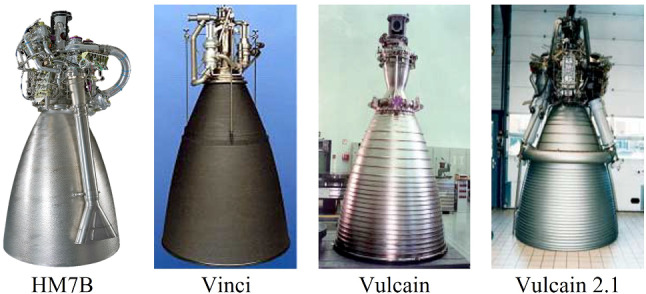
HM7
The engine was developed in 1973 and used as the third stage of the Arian 1 launch vehicle from 1979. The engine adopted a gas generator cycle and produced a specific impulse of 443 s and 6.3 tonf in a vacuum. After that, performance improvement was needed in Ariane 2 and 3. Hence, the HM7B was developed, which increased the combustion pressure and the specific impulse to 35 bar and by 4 s, respectively, by extending the nozzle length. The general arrangement of the engine is shown in Fig. 16. There are 484 very small nozzles for the hydrogen dump cooling at the end of nozzle extension, which had an area expansion ratio of 5.7:1 [33].
Fig. 16.

Schematic drawings of HM7B engine [33]
Vinci
The Vinci engine is scheduled to be used in the upper stage of the Ariane 6, the ESA's next-generation launcher: its development began in 2003 with an aim to launch it in 2020. The engine is adopted an expander cycle and produced a specific impulse of 457 s and 18.3 tonf in a vacuum. It was designed to reignite more than five times, allowing various orbits and positions to be selected. Figure 17 shows the schematic of the regenerative cooling channel of the Vinci engine. The engine is applied the co-flow cooling routing method in which the flow direction of the gas and that of the coolant inside the chamber is the same. Unlike counter-flow cooling, where hydrogen is heated first in the nozzle, hydrogen enters the combustion chamber first, creating a greater heat flux to minimize pressure loss and reduce the risk of breakage due to temperature difference at the temperature nozzle throat, increasing lifespan. The endothermic capacity can be improved through the long chamber shape [34].
Fig. 17.

Thrust chamber and cooling channel of the Vinci engine [34]
Vulcain
The Vulcain engine was a gas generator cycle engine developed by Safran Aircraft Engines (Snecma), France, between 1988 and 1996; it was used as a booster engine for Ariane 5. The engine produced a specific impulse of 431 s and 116.2 tonf in a vacuum. Currently, Ariane 5 uses the Vulcain 2 engine. Vulcain 2.1 is in the development phase, which will be used in the Ariane 6 launch vehicle. Vulcain 2.1 engine produced a specific impulse of 434 s and 137.7 tonf in a vacuum. The nozzle expansion part of the engine was reinforced, and it has a structure in which the combustion gas that drives the turbine is recycled to the nozzle expansion part [35].
Russia
Russia's liquid rocket engine technology began in 1957 when Sputnik-1—the world's first artificial satellite—was launched using an R-7 launch vehicle [36]. However, there was no experience in developing a hydrogen-fueled rocket for a long time. The development of a hydrogen-fueled engine was stimulated by the successful development of the US SSME launch vehicle and the high transport capacity of the Saturn V.
The first hydrogen-fueled engine, the RD-0120, was launched in 1987. Furthermore, the KVD-1 was established in 2001; however, it was then retired. They are currently developing the upper stage KVTK of the Angara A5 launch vehicle by applying the RD-0146D engine, which performed the first test launch in 2012. Its ignition and re-ignition tests were reportedly successful using a laser ignition system. Table 6 lists the specifications of major hydrogen-fueled rocket engines of Russia. It shows that the specific impulse of these engine is around 460 s, and the thrust-to-weight ratio of the RD-0120 is higher than that of other engines. The thrust-to-weight ratio of the RD-0146 is slightly lower than 40, which is similar to that of China and lower than that of the United States or Japan.
Table 6.
Characteristics of hydrogen-fueled rocket engine of Russia
| Engine | RD-0120 | RD-701 | KVD-1 | RD-0146 |
|---|---|---|---|---|
| Cycle | Staged combustion | Staged combustion (tri-propellant) | Staged combustion | Expander |
| Status | Retired | Cancelled | Retired | Under development |
| Development period | 1976–1987 | –1988 | 1960s | 2001 ~ |
| First flight | 1987 | – | 2001 | 2027 (plan) |
| Thrust [tf] | 189.7 |
407.9 (mode 1) 163.2 (mode 2) |
7.1 | 10.0 |
| Chamber pressure [bar] | 206 | 300 | 56 | 59 |
| Specific impulse [s] | 455.5 |
415 (mode 1) 460 (mode 2) |
462 | 460 |
| Thrust-to-weight ratio | 55.0 | 75.0 | 25.2 | 38.3 |
| Application | Energia core stage | MAKS Orbiter | GSLV Mk.1 3rd stage | Angara A5 upper stage |
RD-0120
The RD-0120 was Soviet Union's first hydrogen-fueled engine, which was launched in 1987. The engine adopted a staged combustion cycle and produced a specific impulse of 455.5 s and 190 tonf in a vacuum. Figure 18 shows the structure of the RD-0120. It had a single-shaft system in which the turbine was coaxially connected to the pump [37]. It can be confirmed that the engine was adopted a staged combustion cycle that the combustion gas generated from the pre-burner drove the turbine and entered the combustion chamber.
Fig. 18.
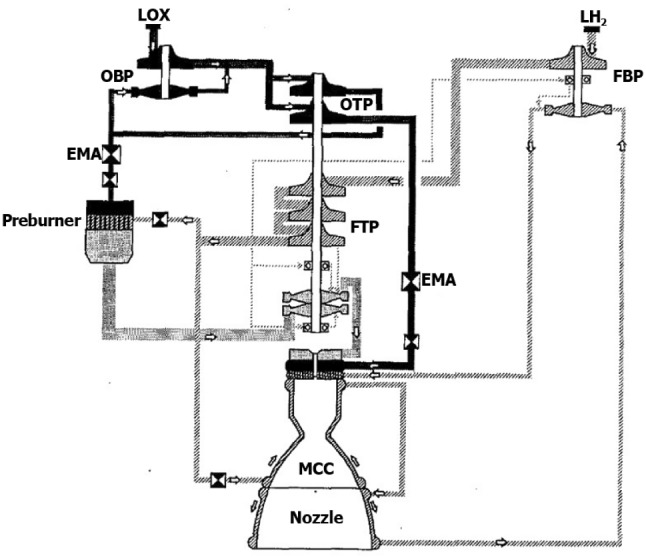
Schematic diagram of RD-0120 engine [38]
RD-701
The RD-701 engine was designed to be reused through the multipurpose aerospace system (MAKS) spaceplane project; however, its development was stopped due to the project's cancellation. This engine could be operated in two modes. Mode 1 operated at low altitudes and used a fuel mixture of kerosene and liquid hydrogen, and Mode 2 operated at high altitudes and used liquid hydrogen fuel. It had the highest combustion pressure of 300 bar until 2020; SpaceX's Raptor engine broke this record at 330 bar in August 2020 (Fig. 19).
Fig. 19.

RD-701 engine [39]
KVD-1
The KVD-1 engine was developed in the early 1960s in the upper stage of the N-I launch vehicle for the Soviet Union manned lunar exploration; however, it was temporarily halted after four failed launches. It was then used for the Indian Space Research Organization (ISRO) program through a technology agreement with India in 1991 and was last released in 2010.
RD-0146
The RD-0146 engine is the hydrogen-fueled engine of Russia in the expander cycle, in which turbopumps are driven by waste heat absorbed in the nozzle and combustion chamber, as shown in Fig. 20. The engine produced a specific impulse of 460 s and 10 tonf in a vacuum. The engine made it possible to achieve high efficiency and minimize the pump's size and weight through a high rotational speed of approximately 123,000 rpm of fuel pump [40]. The engine used an expansion nozzle using a heat-resistant carbon composite to increase the efficiency of the expander cycle and a high-strength nickel-based alloy and heat-resistant steel to reduce the weight of the combustion chamber by 30%. In addition, the size and weight of the combustion chamber were reduced by designing a cooling fin inside the combustion chamber cooling channel [41].
Fig. 20.
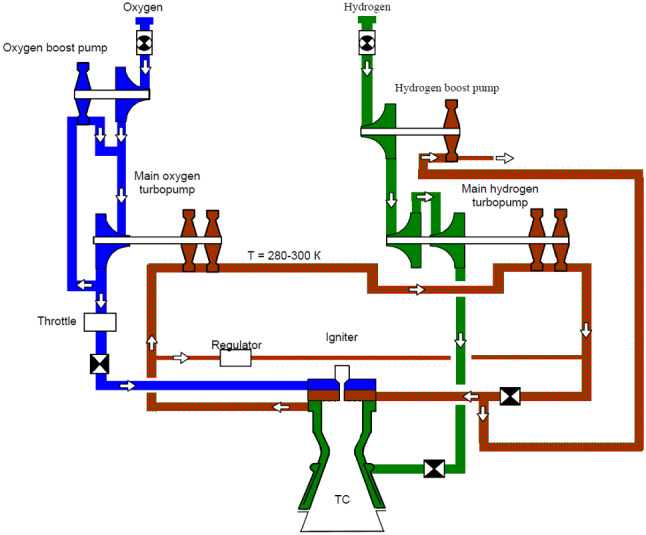
Flow schematics of RD-0146 engine [40]
Comparison with kerosene-fueled engine
Based on the upper engine, the characteristics of the kerosene-fueled engine and the hydrogen-fueled engine are shown in Tables 7 and 8. The hydrogen-fueled engine had about 30% higher specific impulse than the kerosene-fueled engine, but the thrust and thrust-to-weight ratio were low. The lower thrust-to-weight ratio of the hydrogen-fueled engines is due to the difference in the engine cycle. The hydrogen-fueled engine mainly adopted the expander cycle and, therefore, has a lower combustion pressure. But the kerosene-fueled engine primarily adopted the staged combustion cycle. It is interpreted that the kerosene-fueled engine is trying to compensate for the disadvantage of lower specific impulse compared to the hydrogen-fueled engine through high combustion pressure. However, the complex structure of the staged combustion cycle and the increased combustion pressure cause a decrease in reliability, which can be seen as a disadvantage of the launch vehicle that requires high reliability.
Table 7.
Characteristics of hydrogen-fueled rocket engine in the upper stage
| Engine | RL10C-1 | LE-5B | YF-75D | HM7B | RD-0146 |
|---|---|---|---|---|---|
| Cycle | Expander | Expander (Chamber bleed) | Expander | Gas generator | Expander |
| Vac. Thrust [tf] | 10.4 | 15.4 | 9.9 | 7.3 | 10.0 |
| Chamber pressure [bar] | 44.0 | 35.8 | 41 | 61 | 59 |
| Specific impulse [s] | 449.7 | 450 | 442 | 447 | 460 |
| Thrust-to-weight ratio | 57.0 | 51.9 | 41.1 | 40.1 | 38.3 |
Table 8.
Characteristics of kerosene-fueled rocket engine in the upper stage
| Engine | RD-0124 | RD-120 | Merlin 1D (Vacuum) | YF-115 |
|---|---|---|---|---|
| Cycle | Staged combustion | Staged combustion | Gas generator | Staged combustion |
| Vac. Thrust [tf] | 30.0 | 85.0 | 95.2 | 18.0 |
| Chamber pressure [bar] | 156.9 | 162.8 | 97.0 | 120 |
| Specific impulse [s] | 359 | 350 | 348 | 341.5 |
| Thrust-to-weight ratio | 65.2 | 75.6 | 202.8 | – |
Conclusions
This paper analyzed information related to the development status of liquid hydrogen-fueled rocket engines of the developed countries, such as the United States, Japan, China, Europe, and Russia. The countries have verified the reliability and reduced development costs by improving existing engines rather than developing new engines. In addition, the performance is slightly low; however, there has been a tendency to switch from a staged combustion cycle to a gas generator or to an expander cycle to increase reliability and price competitiveness. The specific impulse of the hydrogen-fueled engine was approximately 440–450 s, and the thrust-to-weight ratio of the first-stage engine was about 50, with some exceptions, which was slightly higher than that of the upper-stage. The combustion pressure was more than 100 bar for the first stage engine and approximately 40–50 bar for the upper stage engine.
High-performance engines have been continuously developed to improve price competitiveness and reliability. Various development options and methods can be applied, such as selecting a fuel other than kerosene and applying methods other than a gas generator. Moreover, a hydrogen-fueled rocket engine can also be a solution. Many infrastructures are being built based on the hydrogen economy policy around the world. Hence, a reduction in the production price of liquid hydrogen can be expected. In addition, it is possible to improve the payload through large specific impulse and reliability through the expander cycle compared to other fuels. This feature is expected to be a great advantage, especially for applications on the upper stage of the large launch vehicle. The data analyzed in this paper can likely be used as fundamental data to set the direction of R&D for the next-generation launch vehicle and develop a cryogenic-fueled engine, such as hydrogen and methane.
Acknowledgements
This research was supported by through the Space Core Technology Development Program of the National Research Foundation (NRF) funded by the Ministry of Science and ICT (MICT) of the Republic of Korea (Grant No. NRF-2021M1A3B8078916).
Footnotes
Publisher's Note
Springer Nature remains neutral with regard to jurisdictional claims in published maps and institutional affiliations.
References
- 1.Burkhardt H, Sippel S, Herbertz A, Klevanski J. Kerosene vs. methane: a propellant tradeoff for reusable liquid booster stages. J Spacecr Rockets. 2004;41(5):762–769. doi: 10.2514/1.2672. [DOI] [Google Scholar]
- 2.CNBC (2021) https://www.cnbc.com/2021/11/30/elon-musk-to-spacex-starships-raptor-engine-crisis-risks-bankruptcy.html. Accessed 14 Jan 2022
- 3.Koroneos C, Dompros A, Roumbas G, Moussiopoulos N. Advantages of the use of hydrogen fuel as compared to kerosene. Resour Conserv Recycl. 2005;44(2):99–113. doi: 10.1016/j.resconrec.2004.09.004. [DOI] [Google Scholar]
- 4.Mehendiratta D, Ramachandran M. A review on different propellant materials for space vehicles and their characterisation. Int J Mech Prod Eng Res Dev. 2018;2018:93–102. [Google Scholar]
- 5.Katsarelis C, Chen P, Gradl P, Protz C, Jones Z, Ellis D, Evans L (2019) Additive manufacturing of NASA HR-1 material for liquid rocket engine component applications (No. M19-7797)
- 6.Space Foundation (2022) The Space Report 2021 Q4
- 7.Cecere D, Giacomazzi E, Ingenito A. A review on hydrogen industrial aerospace applications. Int J Hydrog Energy. 2014;39(20):10731–10747. doi: 10.1016/j.ijhydene.2014.04.126. [DOI] [Google Scholar]
- 8.Baroutaji A, Wilberforce T, Ramadan M, Olabi AG. Comprehensive investigation on hydrogen and fuel cell technology in the aviation and aerospace sectors. Renew Sustain Energy Rev. 2019;106:31–40. doi: 10.1016/j.rser.2019.02.022. [DOI] [Google Scholar]
- 9.NASA (2020) https://www.nasa.gov/sites/default/files/atoms/files/nasa_human_exploration_operations_program_tagged.pdf. Accessed 14 Jan 2022
- 10.Ballard RO (2017) Next-Generation RS-25 Engines for the NASA Space Launch System NASA M17-6076. In: 7th European Conference for Aeronautics and Space Sciences
- 11.Jewett RP, Halchak JA. The use of alloy 718 in the space shuttle main engine. Superalloys. 1991;718(615):749–760. doi: 10.7449/1991/superalloys.1991.749.760. [DOI] [Google Scholar]
- 12.Dawson G, Ian M, Dowler P, Kontogiannis G, Pech GJ (2013) A decade of success and innovation for evolved expendable launch vehicle liquid propulsion systems. In: 49th AIAA/ASME/SAE/ASEE joint propulsion conference (p 4148). 10.2514/6.2013-4148
- 13.Wood B (2002) Propulsion for the 21st Century-RS-68. In: 38th AIAA/ASME/SAE/ASEE joint propulsion conference and exhibit (p 4324). 10.2514/6.2002-4324
- 14.Blue Origin (2022) https://www.blueorigin.com/engines/be-3. Accessed 14 Jan 2022
- 15.Blue Origin (2022) https://www.blueorigin.com/news/be7-engine-testing. Accessed 14 Jan 2022
- 16.Blue Origin (2022) https://www.blueorigin.com/engines/be-7. Accessed 14 Jan 2022
- 17.(2022) https://www.b14643.de/Spacerockets/Specials/P&W_RL10_engine/. Accessed 14 Jan 2022
- 18.Sekita R, Yasui M, Warashina S (2000) The LE-5 series development, approach to higher thrust, higher reliability and greater flexibility. In: 36th AIAA/ASME/SAE/ASEE joint propulsion conference and exhibit (p 3453). 10.2514/6.2000-3453
- 19.Kakuma Y, Yasui M, Onga T, Sekita R, Warashina S (2000) LE-5B engine development. In: 36th AIAA/ASME/SAE/ASEE joint propulsion conference and exhibit (p 3775). 10.2514/6.2000-3775
- 20.Fukushima Y, Nakatsuzi H, Nagao R, Kishimoto K, Hasegawa K, Koganezawa T, Warashina S. Development status of LE-7A and LE-5B engine for H-IIA Family. Acta Astronaut. 2002;50(5):275–284. doi: 10.1016/S0094-5765(01)00165-5. [DOI] [Google Scholar]
- 21.Terakado D, Higashi K, Sakaki K, Komaru T, Suwa N, Arimoto Y, Ikemoto A (2019) 2nd qualification test series results of the upper stage engine LE-5B-3 for H3 rocket. In: 8th Europe conference for aeronautics and space sciences. 10.13009/EUCASS2019-626
- 22.Mochizuki M, Sogame E, Shibato Y (1988) Status report of the H-I and H-II vehicles. In: 12th international communication satellite systems conference (p 853)
- 23.Kawashima H, Funakoshi Y, Kurosu A, Kobayashi T, Okita K (2019) Development Status of LE-9 Engine for H3 Launch Vehicle. In: AIAA propulsion and energy 2019 forum (p 4024). 10.2514/6.2019-4024
- 24.NTT Data (2020) https://www.nttd-es.co.jp/magazine/backnumber/no97/no97-specialreport.html. Accessed 14 Jan 2022
- 25.(2022) https://en.wikipedia.org/wiki/Long_March_(rocket_family). Accessed 14 Jan 2022
- 26.Lim KH. Chinese space launch vehicle, Changzheng (CZ) rocket. Defense Technol. 2021;509:122–137. [Google Scholar]
- 27.Spacenews (2021) https://spacenews.com/chinas-super-heavy-rocket-to-construct-space-based-solar-power-station/. Accessed 14 Jan 2022
- 28.Zhang N (2013) The development of LOX/LH2 engine in China. In: 64th international astronautical congress
- 29.Beijing Aerospace Propulsion Institute (2021). https://mp.weixin.qq.com/s/oK3bOJfVtTSqseW5xkbx7A. Accessed 14 Jan 2022
- 30.Cen Z, Gao RF, Shen L (2011) LM-3A Series Launch Vehicle User’s Manual. In: China Academy of Launch Vehicle Technology, Beijing, pp 13–14
- 31. Ars Techica (2021) https://arstechnica.com/science/2021/06/europes-space-chief-appoints-task-force-to-assess-ariane-6-schedule-concerns/. Accessed 14 Jan 2022
- 32.AraineGroup (2017) https://www.ariane.group/wp-content/uploads/2020/06/HM7B_2017_11_PS_EN_Web.pdf. Accessed 14 Jan 2022
- 33.Pouliquen M, Gill GS. Performance characteristics of the HM7 rocket engine for the Ariane launcher. J Spacecr Rockets. 1979;16(6):367–372. doi: 10.2514/3.57676. [DOI] [Google Scholar]
- 34.Knab O, Fröhlich A, Wennerberg D, Haslinger W (2002) Advanced cooling circuit layout for the Vinci expander cycle thrust chamber. In 38th AIAA/ASME/SAE/ASEE joint propulsion conference & exhibit (p 4005). 10.2514/6.2002-4005
- 35.Coulon D. Vulcain-2 cryogenic engine passes first test with new nozzle extension. ESA Bull. 2000;102:123–124. [Google Scholar]
- 36.Han SY. The worldwide status of technology development of liquid-propellant rocket engine for launch vehicle. Curr Ind Technol Trends Aerospace. 2012;10(1):132–144. [Google Scholar]
- 37.Ha SU, Moon LY, Moon IS, Cho WK, Lee SY. Domestic and foreign technology and development trends in staged-combustion cycle rocket engines. Curr Ind Technol Trends Aerospace. 2014;12(2):136–150. [Google Scholar]
- 38.Rachuk V, Goncharov N, Martynenko Y, Barinshtejn, B, Sciorelli, F (1995) Design, development, and history of the oxygen/hydrogen engine RD-0120. In: 31st AIAA/ASME/SAE/ASEE joint propulsion conference and exhibit (p 2540)
- 39.Tkachenko J, Limerick C (1993) Powerful liquid rocket engine (LRE) created by NPO Energomash for up to date space rockets. In 29th AIAA/ASME/SAE/ASEE Joint Propulsion Conference and Exhibit (p. 1957).
- 40.Rachuk V, Titkov N (2006) The First Russian LOX-LH2 Expander Cycle LRE: RD0146. In: 42nd AIAA/ASME/SAE/ASEE joint propulsion conference & exhibit (p 4904). 10.2514/6.2006-4904
- 41.Anatoly Zak (2021) http://www.russianspaceweb.com/rd0146.html. Accessed 14 Jan 2022



